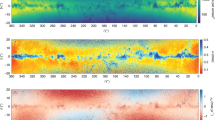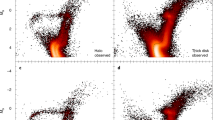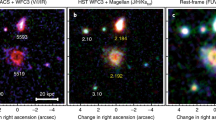Abstract
The Milky Way’s neutral hydrogen (H i) disk is warped and flared1,2. However, a dearth of accurate H i-based distances has thus far prevented the development of an accurate Galactic Disk model. Moreover, the extent to which our Galaxy’s stellar and gas disk morphologies are mutually consistent is also unclear. Classical Cepheids, primary distance indicators with distance accuracies of 3–5% (ref. 3), offer a unique opportunity to develop an intuitive and accurate three-dimensional picture. Here, we establish a robust Galactic Disk model based on 1,339 classical Cepheids. We provide strong evidence that the warp’s line of nodes is not oriented in the Galactic Centre–Sun direction. Instead, it subtends a mean angle of 17.5° ± 1° (formal) ± 3° (systematic) and exhibits a leading spiral pattern. Our Galaxy thus follows Briggs’ rule for spiral galaxies4, which suggests that the origin of the warp is associated with torques forced by the massive inner disk5. The stellar disk traced by Cepheids follows the gas disk in terms of their amplitudes; the stellar disk extends to at least 20 kpc (refs. 6,7). This morphology provides a crucial, updated map for studies of the kinematics and archaeology of the Galactic Disk.
This is a preview of subscription content, access via your institution
Access options
Access Nature and 54 other Nature Portfolio journals
Get Nature+, our best-value online-access subscription
$29.99 / 30 days
cancel any time
Subscribe to this journal
Receive 12 digital issues and online access to articles
$119.00 per year
only $9.92 per issue
Buy this article
- Purchase on Springer Link
- Instant access to full article PDF
Prices may be subject to local taxes which are calculated during checkout




Similar content being viewed by others
Data availability
The full data set of our Cepheid sample is available in Supplementary Data 1. In general, the data supporting the plots in this paper and other findings of this study are available from the corresponding author upon reasonable request.
References
Levine, E. S., Blitz, L. & Heiles, C. The vertical structure of the outer Milky Way H i disk. Astrophys. J. 643, 881–896 (2006).
Kalberla, P. M. W., Dedes, L., Kerp, J. & Haud, U. Dark matter in the Milky Way. II. The H i gas distribution as a tracer of the gravitational potential. Astron. Astrophys. 469, 511–527 (2007).
Wang, S., Chen, X., de Grijs, R. & Deng, L. The near-infrared optimal distances method applied to Galactic classical Cepheids tightly constrains mid-infrared period–luminosity relations. Astrophys. J. 852, 78 (2018).
Briggs, F. H. Rules of behavior for Galactic warps. Astrophys. J. 352, 15–29 (1990).
Shen, J. & Sellwood, J. A. Galactic warps induced by cosmic infall. Mon. Not. R. Astron. Soc. 370, 2–14 (2006).
Liu, C., Xu, Y., Wang, H. & Wan, J. Rediscovering the Galactic outer disk with LAMOST data. Proc. Int. Astron. Union Vol. 13 (eds Chiappini, C., Minchev, I., Starkenberg, E. & Valentini, M.) 109–115 (International Astronomical Union, 2018).
Wang, H., Liu, C., Xu, Y., Wan, J. & Deng, L. Mapping the Milky Way with LAMOST—III. Complicated spatial structure in the outer disc. Mon. Not. R. Astron. Soc. 478, 3367–3379 (2018).
Chen, X., Wang, S., Deng, L., de Grijs, R. & Ming, Y. Wide-field Infrared Survey Explorer (WISE) catalog of periodic variable stars. Astrophys. J. Suppl. Ser. 273, 28 (2018).
Chen, X., Wang, S., Deng, L. & de Grijs, R. An extremely low mid-infrared extinction law toward the Galactic Center and 4% distance precision to 55 classical Cepheids. Astrophys. J. 859, 137 (2018).
Gaia Collaboration. Gaia Data Release 2. Summary of the contents and survey properties. Astron. Astrophys. 616, A1 (2018).
Haario, H., Laine, M., Mira, A. & Saksman, E. DRAM: efficient adaptive MCMC. Stat. Comput. 16, 339–354 (2006).
Abedi, H. et al. Characterizing the Galactic warp with Gaia—I. The tilted ring model with a twist. Mon. Not. R. Astron. Soc. 442, 3627–3642 (2014).
Drimmel, R. & Spergel, D. N. Three-dimensional structure of the Milky Way Disk: the distribution of stars and dust beyond 0.35 R 0. Astrophys. J. 556, 181–202 (2018).
López-Corredoira, M., Cabrera-Lavers, A., Garzón, F. & Hammersley, P. L. Old stellar Galactic Disc in near-plane regions according to 2MASS: scales, cut-off, flare and warp. Astron. Astrophys. 394, 883–899 (2002).
Yusifov, I. Pulsars and the warp of the Galaxy. In The Magnetized Interstellar Medium: Proc. Conference held in Antalya, Turkey (eds Uyaniker, B., Reich, W. & Wielebinski, R.) 165–169 (Copernicus GmbH, 2004).
Skrutskie, M. F. et al. The Two Micron All Sky Survey (2MASS). Astron. J. 131, 1163–1183 (2006).
Amores, E. B., Robin, A. C. & Reylé, C. Evolution over time of the Milky Way’s disc shape. Astron. Astrophys. 602, A67 (2017).
Poggio, E. et al. The Galactic warp revealed by Gaia DR2 kinematics. Mon. Not. R. Astron. Soc. 481, L21–L25 (2018).
Burton, W. B. in Galactic and Extragalactic Radio Astronomy 2nd edn (eds Verschuur, G. & Kellermann, K.) 295–358 (Springer-Verlag, Berlin and New York, 1988).
Momany, Y. et al. Outer structure of the Galactic warp and flare: explaining the Canis Major over-density. Astron. Astrophys. 451, 515–538 (2006).
Bland-Hawthorn, J. & Gerhard, O. The Galaxy in context: structural, kinematic, and integrated properties. Annu. Rev. Astron. Astrophys. 54, 529–596 (2016).
de Grijs, R. & Bono, G. Clustering of local group distances: publication bias or correlated measurements? IV. The Galactic Center. Astrophys. J. Suppl. Ser. 227, 5 (2016).
Freedman, D. & Diaconis, P. On the histogram as a density estimator: L2 theory. Probab. Theory Relat. Fields 57, 453–476 (1981).
Reid, M. J. et al. Trigonometric parallaxes of high mass star forming regions: the structure and kinematics of the Milky Way. Astrophys. J. 783, 130 (2014).
Schonrich, R., Binney, J. & Dehnen, W. Local kinematics and the local standard of rest. Mon. Not. R. Astron. Soc. 403, 1829–1833 (2010).
Antoja, T. et al. A dynamically young and perturbed Milky Way disk. Nature 561, 360–362 (2018).
Freeman, K. C. On the disks of spiral and S0 galaxies. Astrophys. J. 160, 811–830 (1970).
Feast, M. W., Menzies, J. W., Matsunaga, N. & Whitelock, P. A. Cepheid variables in the flared outer disk of our Galaxy. Nature 509, 342–344 (2014).
Berdnikov, L. N. VizieR Online Data Catalog: Photoelectric Observations of Cepheids in UBV(RI)c II/285 http://vizier.cfa.harvard.edu/viz-bin/VizieR?-source=II/285 (2008).
Soszyński, I. et al. The OGLE collection of variable stars. Classical Cepheids in the Magellanic system. Acta Astron. 65, 297–312 (2015).
Fernie, J. D., Evans, N. R., Beattie, B. & Seager, S. A database of Galactic classical Cepheids. Inform. Bull. Variable Stars 4148, 1 (1995).
Pojmanski, G., Pilecki, B. & Szczygiel, D. The All Sky Automated Survey. Catalog of variable stars. V. Declinations 0°–+28° of the Northern Hemisphere. Acta Astron. 55, 275–301 (2005).
Samus, N. N., Kazarovets, E. V., Durlevich, O. V., KireevaN. N.. & Pastukhova, E. N. General catalogue of variable stars: version GCVS 5.1. Astron. Rep. 61, 80–88 (2017).
Jayasinghe, T. et al. The ASAS-SN catalogue of variable stars. I. The Serendipitous Survey. Mon. Not. R. Astron. Soc. 477, 3145–3163 (2018).
Heinze, A. N. et al. A first catalog of variable stars measured by the Asteroid Terrestrial-impact Last Alert System (ATLAS). Astron. J. 156, 241 (2018).
Clementini, G. et al. Gaia Data Release 2: Specific characterisation and validation of all-sky Cepheids and RR Lyrae stars. Astron. Astrophys. (in the press).
Churchwell, E. et al. The Spitzer/GLIMPSE surveys: a new view of the Milky Way. Publ. Astron. Soc. Pac. 121, 213–230 (2009).
Wright, E. L. et al. The Wide-field Infrared Survey Explorer (WISE): mission description and initial on-orbit performance. Astron. J. 140, 1868–1881 (2010).
Chen, X., de Grijs, R. & Deng, L. New open cluster Cepheids in the VVV survey tightly constrain near-infrared period–luminosity relations. Mon. Not. R. Astron. Soc. 464, 1119–1126 (2017).
Matsunaga, N. et al. Three classical Cepheid variable stars in the nuclear bulge of the Milky Way. Nature 477, 188–190 (2011).
Dékány, I. et al. The VVV survey reveals classical Cepheids tracing a young and thin stellar disk across the Galaxy's bulge. Astrophys. J. 812, L29 (2015).
Inno, L. et al. New NIR light-curve templates for classical Cepheids. Astron. Astrophys. 576, 30 (2015).
Freedman, W. L. et al. Carnegie Hubble Program: a mid-infrared calibration of the Hubble constant. Astrophys. J. 758, 24 (2012).
Matsunaga, N. et al. Impact of distance determinations on Galactic structure. I. Young and intermediate-age tracers. Space Sci. Rev. 214, 74 (2018).
Zasowski, G. et al. Lifting the dusty veil with near- and mid-infrared photometry. II. A large-scale study of the Galactic infrared extinction law. Astrophys. J. 707, 510–523 (2009).
Xue, M. et al. A precise determination of the mid-infrared interstellar extinction law based on the APOGEE spectroscopic survey. Astrophys. J. Suppl. Ser. 224, 23 (2016).
Indebetouw, R. et al. The wavelength dependence of interstellar extinction from 1.25 to 8.0 μm using GLIMPSE data. Astrophys. J. 619, 931–938 (2005).
Cardelli, J. A., Clayton, G. C. & Mathis, J. S. The relationship between infrared, optical, and ultraviolet extinction. Astrophys. J. 345, 245–256 (1989).
Riess, A. et al. Milky Way Cepheid standards for measuring cosmic distances and application to Gaia DR2: implications for the Hubble constant. Astrophys. J. 861, 126 (2018).
Wouterloot, J. G. A., Brand, J., Burton, W. B. & Kwee, K. K. IRAS sources beyond the solar circle. II Distribution in the Galactic warp. Astron. Astrophys. 230, 21–36 (1990).
Acknowledgements
We are grateful for research support from the National Key Basic Research Program of China 2014CB845700. This work is also supported by the National Natural Science Foundation of China through grants U1631102, 11373010 and 11633005, the Initiative Postdocs Support Program (No. BX201600002), the China Postdoctoral Science Foundation (grant 2017M610998) and the National Key Research and Development Program of China (grant 2017YFA0402702).
Author information
Authors and Affiliations
Contributions
X.C. contributed to the project planning, data preparation and analysis, modelling, simulations and writing of the final paper. S.W. contributed to the data analysis and writing of the paper. L.D. contributed to project planning and research support. R.d.G. engaged in detailed scientific discussions and contributed to writing of the paper and final editing. C.L. contributed to the exploration of the warp’s precession. H.T. contributed to implementation of the techniques used for the modelling and simulations. All authors reviewed and commented on the manuscript.
Corresponding authors
Ethics declarations
Competing interests
The authors declare no competing interests.
Additional information
Publisher’s note: Springer Nature remains neutral with regard to jurisdictional claims in published maps and institutional affiliations.
Supplementary information
Supplementary Information
Supplementary Tables 1–2; Supplementary Video 1 caption; Supplementary Data 1 caption; Supplementary Figs. 1–5.
Supplementary Video 1
3D animation of Fig. 1a.
Supplementary Data 1
Cepheid catalogue used in the research.
Rights and permissions
About this article
Cite this article
Chen, X., Wang, S., Deng, L. et al. An intuitive 3D map of the Galactic warp’s precession traced by classical Cepheids. Nat Astron 3, 320–325 (2019). https://doi.org/10.1038/s41550-018-0686-7
Received:
Accepted:
Published:
Issue Date:
DOI: https://doi.org/10.1038/s41550-018-0686-7
This article is cited by
-
A tilted dark halo origin of the Galactic disk warp and flare
Nature Astronomy (2023)
-
Evidence of a dynamically evolving Galactic warp
Nature Astronomy (2020)



